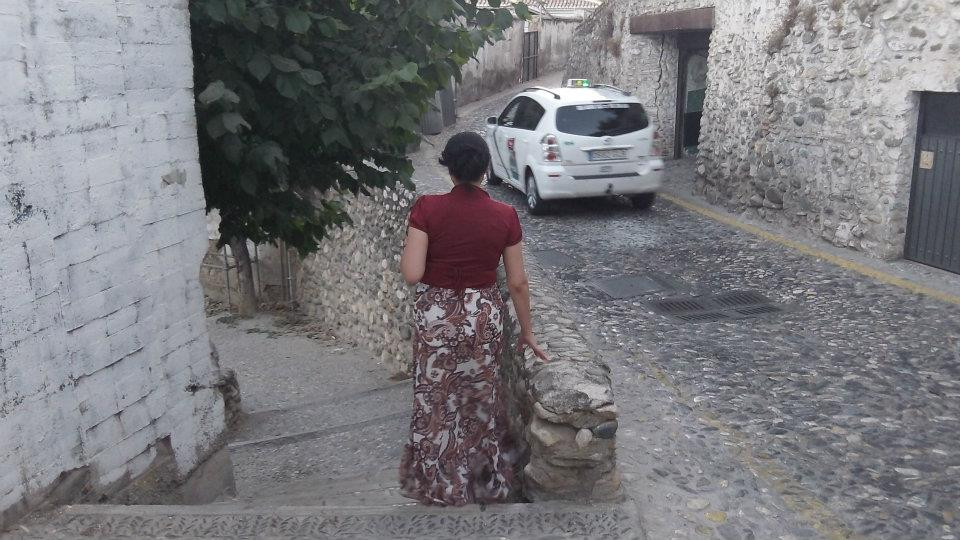During my travels through Spain, the term Duende kept surfacing. Initially, with my understanding of folklore, I associated it with the Spanish word for elf. Knowing Spain’s rich tapestry of ancient superstitions, the idea of being wary of a Duende, or elf, wasn’t entirely surprising. However, the context shifted when I started hearing flamenco dancers and singers in tapas bars use phrases like “she has el Duende” or “he surely has Duende.” Intrigued, I asked a bartender, “What’s this Duende all about?” His simple reply was, “Just watch the show, and you’ll see.” And so I watched, expecting perhaps a mischievous elf to leap onto the stage.
 Author Carolyn Pachas walks down a cobblestone street in Spain, seeking to understand the concept of Duende in Spanish art forms.
Author Carolyn Pachas walks down a cobblestone street in Spain, seeking to understand the concept of Duende in Spanish art forms.
Beyond the Myth: Experiencing Duende in Flamenco
As the flamenco show progressed, no elf appeared. Instead, I witnessed raw emotion etched on the singer’s face, and the dancer moved with alternating currents of sorrow and elation. Tears welled in my eyes, and I understood. This wasn’t about mythical creatures; it was about a potent emotion that grips you, sending shivers down your spine and igniting an inexplicable urge to dance flamenco yourself, even without knowing the steps. This powerful feeling, this very essence, explains why Spain ignites a passion for flamenco in so many. Countless tourists, after just a brief Spanish holiday, find themselves enrolling in flamenco dance classes back home. I myself was searching for flamenco schools the moment I returned.
Years later, delving deeper into the study of flamenco, I finally grasped that this overwhelming emotion was Duende. This profound feeling of awe is universally relatable. Think of reading your old diary and being moved to tears by your own words – that’s your Duende manifesting from your soul. Singing a song with unrestrained passion, joy, and pure happiness? That’s Duende. Or consider a moment of intense argument, where you express yourself with every fiber of your being, feeling utterly liberated – that too, is Duende emerging from your core. In the realm of dance, particularly flamenco dance, Duende is that captivating force that elevates mere steps into breathtaking art.
 Humorous image depicting the intensity of Duende, contrasting the expected mystical elf with the real, powerful emotional force in flamenco.
Humorous image depicting the intensity of Duende, contrasting the expected mystical elf with the real, powerful emotional force in flamenco.
Duende Defined: The Soul in Performance
The Merriam-Webster Dictionary defines Duende, especially in flamenco and other art forms, as “the power to deeply move or stir.” It’s the mystical and compelling force a performer emanates, captivating the audience. I would add that Duende isn’t solely about audience engagement; it often arises spontaneously, born from genuine emotion and sincerity within the performer. In duende dance, this sincerity is palpable, drawing viewers into the heart of the performance.
Federico Garcia Lorca, the celebrated Spanish writer, eloquently described Duende in his “Theory and Play of the Duende,” stating that “the great artists of Southern Spain, Gypsy or flamenco, singers dancers, musicians, know that emotion is impossible without the arrival of the Duende.”
I wholeheartedly agree with Garcia Lorca’s perspective. Emotion is integral to Duende. Without it, flamenco, and especially duende dance, would be devoid of soul. He called it a “mysterious force that everyone feels and no philosopher has explained.” The next time you witness a flamenco performance, consciously try to identify the Duende in the music and the movements of the dancer. This active engagement is a great way to understand the essence of Duende in flamenco.
Many flamenco songs are narratives of profound human experiences – love, joy, loss, and sorrow. Each region of Spain carries its own history of suffering and resilience. Some regions endured plagues and the heartbreaking loss of children, while others mourned husbands and fathers lost in mines or the Spanish Civil War. The Gypsy community in Spain, historically marginalized and relegated to unfavorable lands, gifted the world with flamenco. Their enduring family traditions and strong sense of community provided the strength to persevere against adversity. To delve deeper, explore my blog post on the origins of flamenco and Andalusian history.
Share this:
Like Loading…
Related
Published by Carolyn Pachas
Communications, public relations, advertising, marketing, real estate. View all posts by Carolyn Pachas
